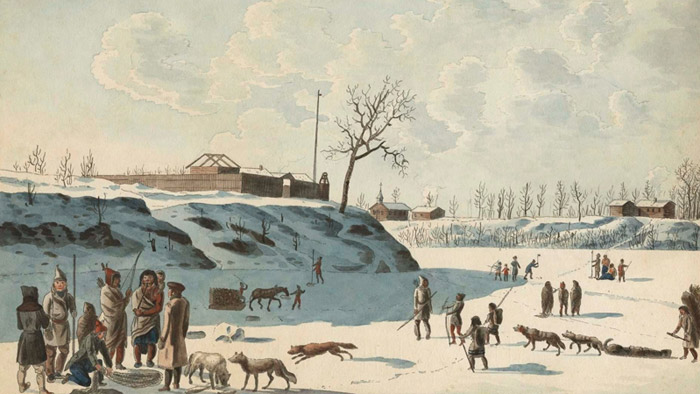Village News
Who is my Neighbour?

Over the past several months, the Village News has focused heavily on the Mennonite settlers from Imperial Russia (modern Ukraine) and their first experience of Manitoba 150 years ago. We have looked at the first families of Steinbach and the various other original East Reserve. There are many villages lost to time or to the consolidation into larger communities and I encourage you to explore those, either by picking up the Historical Atlas of the East Reserve or by visiting the website Mennotoba. This week, instead of exploring the landscape Mennonites encountered, I would like to focus on the people who occupied the land, those peoples who would become our neighbours.
Thousands of years before the arrival of Europeans, First Nations peoples settled these lands. After the melting of the Laurentide ice sheet and the eventual draining of Lake Agassiz allowed access to Southeast Manitoba about 8000 years ago, groups of people began to settle the area. The Assiniboine from the South, the Cree from the West, the Dené from the North and the Ojibwe (Anishinabe) from the East all called this land home. The land of the East Reserve is the traditional territory of the Roseau River Anishinaabe who traversed the lands for hunting and ceremony. In 1871, the signing of Treaty 1 led to the relegation of the Roseau River Anishinabe First Nation to a small parcel of land to the South, along the Red and Roseau Rivers.
In 1811, Lord Selkirk acquired land from the Hudson Bay Company as a means of providing for Scottish farmers displaced from their homes by large sheep farming operations. Forming the Red River Colony, these settlers came into conflict with Métis communities, who had traditionally aligned with the North West Company. The Métis saw the newcomers’ desire to settle and farm as a challenge to their traditional hunting and trapping livelihoods. These tensions grew until a skirmish broke out between the rival groups in 1816 at the battle of Seven Oaks, resulting in 22 deaths. This period saw the Métis settle in communities along the Red, Rat, La Salle and Seine Rivers, transitioning to a life of mixed pursuits between farming, hunting and trapping.
The closest settlements of mixed Métis and French ‘Habitants’ settlers were Pointe de Chênes (Ste. Anne), Lorette and Ile des Chênes to the North, and St. Pierre and La Rochelle to the West. The parish at Ste. Anne was established in 1856 and served as a stop on the Canadian overland route into Manitoba, the Dawson Trail. This community provided a significant amount of lumber for the building of the second Saint Boniface cathedral by Bishop Norbert Provencher, completed in 1832. When this burnt down in 1860, a new cathedral was commissioned by Bishop Taché and built within 8 years. St. Pierre was founded along the Crow Wing trail in the early 1870s by Richot and Dubuc from St. Norbert, undertaking the expedition to the new village site on the Feast of St. Pierre et Paul. Father Jean-Marie Jolys was the first priest in the region, gifting his namesake to the town. La Broquerie was settled in 1875 by French-Canadian settlers, with the parish being established in 1883.
Nestled in on the verge of the East Reserve was the Clearsprings Settlement on the northern edge of Steinbach, where the MHV currently stands. Settled by John and Bertha Mack and Thomas Slater, these settlers of Irish origin came to Manitoba in 1869, having previously settled in Huron County, Ontario. After the land survey of 1872, they applied for homesteads and were joined by four other families; Peter Keating, Thomas & William Laing, and John Peterson. Despite close ties to the surrounding Mennonite communities of Steinbach, Blumenort and Blumenhof, the Clearsprings Settlers did not intermarry and many of their homesteads were eventually purchased by Mennonite farmers.
There are many other neighbours who arrived after the Mennonites, with the West Reserve being settled in 1875, as well as New Iceland on Lake Winnipeg. Chinese settlers arrived in the late 1870s, mostly settling in Winnipeg and Western Manitoba. Lutheran Germans arrived in 1891 to settle the Friedensfeld area south of Steinbach. Ukrainian settlers began arriving in 1896 and built the first Ukrainian Orthodox church in Canada at Gardenton in 1898. It is worth exploring these communities to learn the rich and diverse heritage of our region. The Musée St-Pierre-Jolys provides a wealth of history and tire d’érable (maple taffy), the Dawson Trail Museum in Richer, the Crow Wing Trail and Fort Dufferin offer amazing interpretation, and there are a plethora of local trails, such as Le Sentier Historique de La Broquerie (historic trail), and the Parc des Rédemptoristes in Ste. Anne. There is so much history to explore right on your doorstep!




